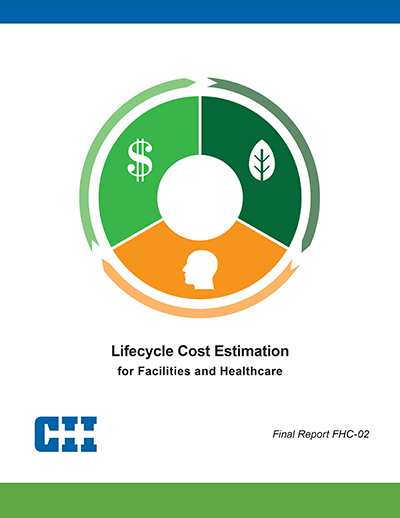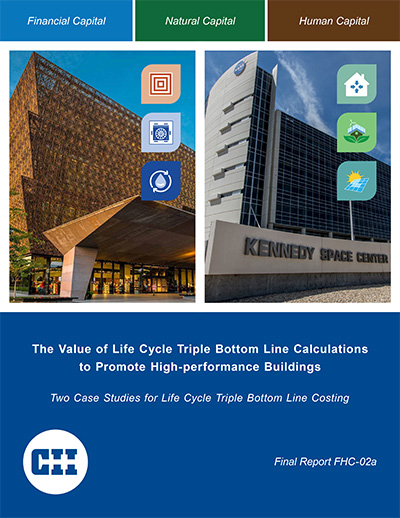
Lifecycle Cost Estimation for Facilities and Healthcare
CII’s Facilities and Healthcare Sector Committee (FHC) challenged Research Team FHC-02 (RT-FHC-02) to consider the economic benefits of high-performance buildings, including integrating holistic benefits such as occupant health and productivity and the environment. The team reviewed standards, guidelines, data sources, and tools to identify opportunities for project teams to improve the quality and performance of the built environment and pulled together a wealth of existing knowledge.
This review was followed by a gap analysis that identified the needs for research and development of new resources, and the barriers to implementing lifecycle value analysis. The research considered three categories of assessment: cost, environmental, and occupant, which are often referred to as the “triple bottom line.”
The research determined the state-of-practice methodologies in facility life cycle costing (LCC) and the resources required for these cost calculations. This book, the team's final report, discusses some of the critical gaps in the existing standards, but also offers guidelines, data sources, and tools. It pinpoints the areas of life cycle value assessment that require additional research before they can be implemented.
During Phase I, the team found that the industry needs standards and guidelines to calculate the economic benefits of high-performance buildings, including integrating holistic benefits such as occupant health and productivity and the environment. Standards exist for facility life cycle costing (LCC), both in the U.S. (e.g., ASTM) and internationally (e.g., ISO). International standards have also been established for conducting life cycle analysis (LCA) in general (e.g., ISO) and specifically for buildings (e.g., CEN-EN). However, RT-FHC-02 did not find standards for calculating the economic impacts of buildings and building systems on occupants’ health, productivity, and performance. Peer-reviewed publications that report on studies of occupant benefits employ different methods and approaches, and a broad consensus does not exist (FR-FHC-02, p. 11).
Recommendation: A standards organization should establish and publish a standard process to measure and monetize the economic benefits of different types of buildings and building systems on the health, efficiency, and productivity of occupants.
In terms of data sources, many sources of comprehensive cost data are proprietary, while relatively few are freely available. Improving the availability and quality of data would improve LCC results (FR-FHC-02, p. 17).
Recommendation: Sponsored data sources maintained by users for users, which can be evaluated and made available for further research and study, would create a resource as well as a community of LCC practitioners. Cost data banks can be sponsored by industry associations for general use. For organizational data, it may be feasible to create a system for systematically collecting life cycle cost data for whole buildings and building systems from past or ongoing projects.
It is essential to have tools that address the cost, environment, and occupant impacts of buildings. Most of these tools found were focused on cost (e.g., LCC tools); few tools or frameworks addressed all three impact areas (FR-FHC-02, p. 7).
Recommendation: Develop tools that include more than one building analysis impact area (i.e., cost, occupant effects, and environmental impacts). The analysis should consider all endpoints affected by buildings and building systems that are important to the organization and/or stakeholders.
Investors and business owners tend not to invest in high-performance building systems that have higher initial costs, even though they decrease costs over the service life (FR-FHC-02, p. 28).
Recommendation: Additional studies need to be conducted to increase interest in and acceptance of the benefits, so that investors and owners will be encouraged to apply building systems that result in occupant benefits and reduce service life costs. There is a need to communicate the benefits of a life cycle value perspective and to develop business cases for better built environments, both to clarify the benefits and to develop straightforward approaches to evaluating the alternatives.



